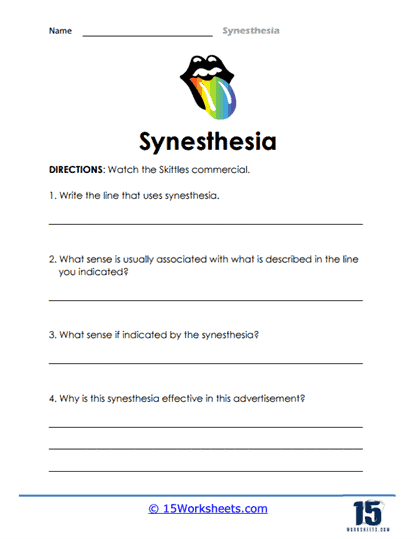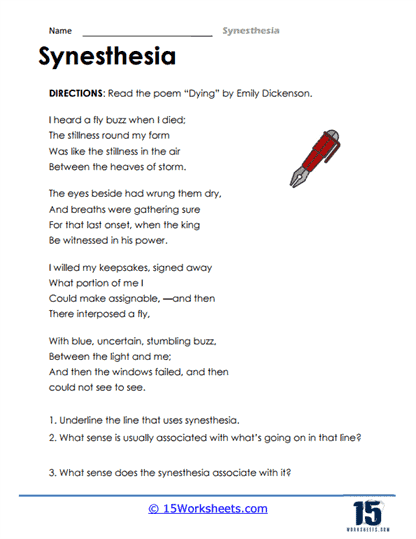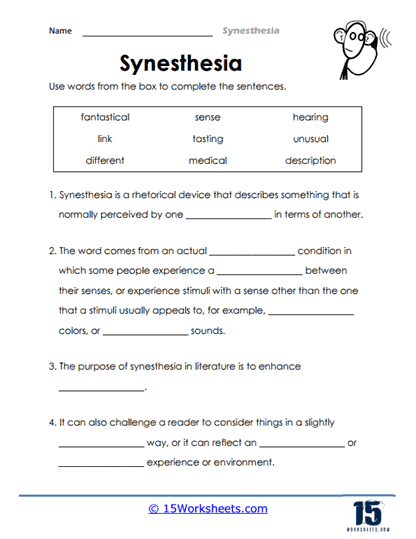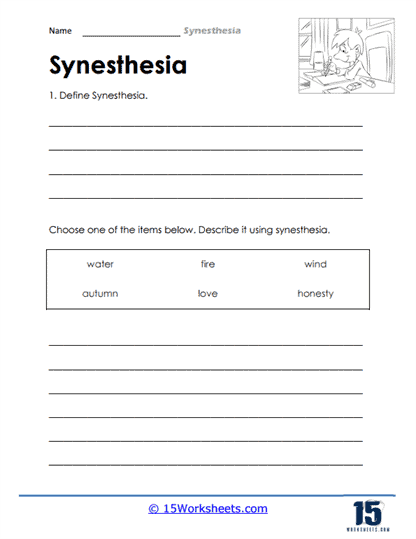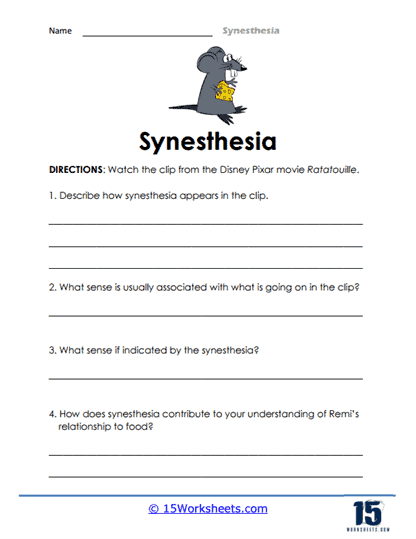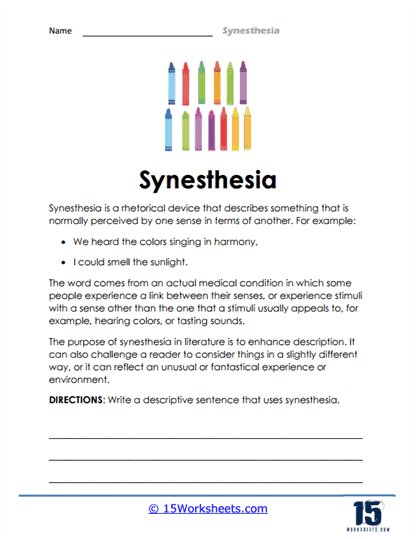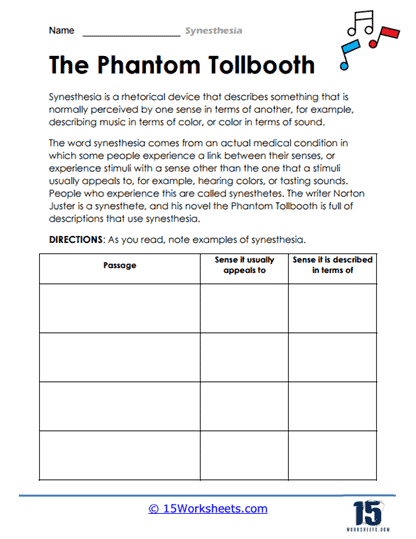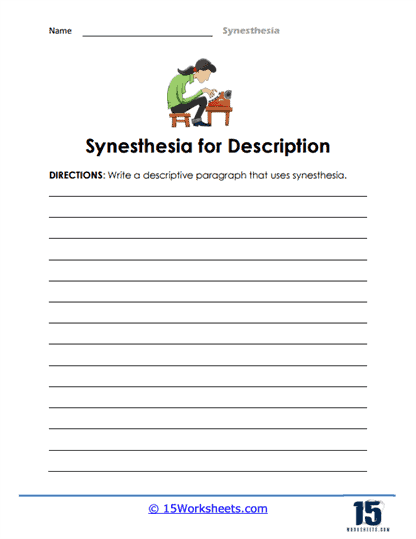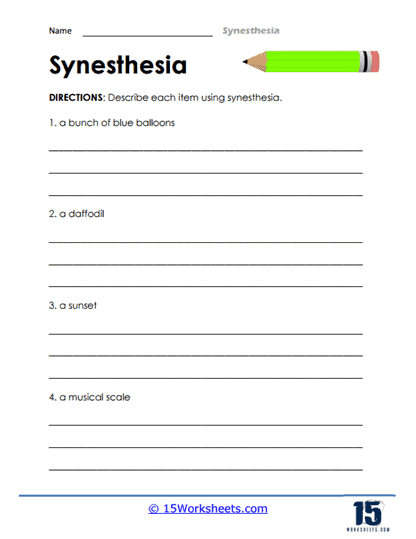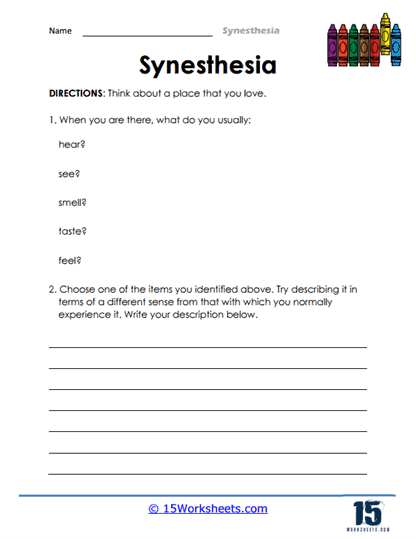Synesthesia Worksheets
About These 15 Worksheets
These worksheets represent a unique and innovative approach to teaching and enhancing language arts and reading skills through the sensory-rich concept of synesthesia. Synesthesia, in a broader sense, is a neurological condition where stimulation of one sensory or cognitive pathway leads to automatic, involuntary experiences in a second sensory or cognitive pathway. In the context of language arts, “synesthetic worksheets” metaphorically apply this concept to encourage students to blend sensory experiences with linguistic and textual analysis, thereby enriching their comprehension, creativity, and engagement with texts.
The goal of the worksheets is to simulate the synesthetic experience, making abstract or complex literary concepts more tangible and relatable through sensory integration. These exercises encourage students to associate colors, sounds, tastes, smells, and tactile sensations with words, phrases, characters, settings, and narratives. This multisensory approach to reading and language comprehension aims to deepen understanding and retention by anchoring abstract concepts in concrete sensory experiences.
By tapping into the multisensory nature of human cognition, these exercises not only improve reading and writing skills but also foster creativity, empathy, and cognitive flexibility. As students explore literature through the lens of synesthesia, they develop a richer, more nuanced understanding of texts and a deeper appreciation for the power of language to evoke the full spectrum of human experience.
Types of Exercises
Color Association – Students are asked to associate specific colors with words, characters, or emotions found in a text. For example, they might color-code words based on the emotions they evoke or assign colors to characters based on their personalities or roles in the story.
Sound Mapping – These exercises encourage students to connect sounds or music to different parts of a text. This could involve choosing a soundtrack that matches the mood of a narrative or creating sound effects that enhance the imagery of a poem.
Taste and Smell Imagery – Students explore descriptive language by associating specific tastes and smells with scenes, settings, or characters. This exercise can help in vividly imagining the text’s environment, enhancing spatial and environmental comprehension.
Tactile Experiences – Tactile exercises might involve associating textures with different aspects of a text, such as the roughness of a character’s voice or the smoothness of a setting’s atmosphere. It can also involve more interactive elements, like creating physical representations of textual features using various materials.
Emotional Mapping – These exercises require students to identify and map the emotions elicited by different parts of a text, using synesthesia as a bridge to connect feelings with sensory experiences (e.g., the warmth of happiness, the coldness of sadness).
Synesthetic Creative Writing – Encourages students to incorporate synesthetic descriptions into their own writing, using sensory experiences to describe scenes, characters, or emotions in a way that blurs the lines between senses.
The Benefits Of These Worksheets
Enhanced Comprehension – By engaging multiple senses, synesthesia worksheets can help students build a more nuanced understanding of texts. This multisensory approach makes abstract concepts more concrete, aiding in comprehension and retention.
Improved Vocabulary – Associating words with sensory experiences encourages students to explore and use descriptive language, enriching their vocabulary and enabling them to express complex ideas more vividly.
Increased Engagement – The novelty and creativity involved in synesthetic exercises can increase students’ interest and engagement with the material. This active involvement fosters a deeper connection with the text and a more enjoyable learning experience.
Creative Thinking – Synesthesia worksheets encourage students to think outside the box by blending sensory experiences with textual analysis. This can stimulate creativity, both in interpreting texts and in students’ own writing, as they learn to use language in innovative ways to evoke sensory experiences.
Emotional Connection – By mapping emotions to sensory experiences, students can develop a stronger emotional connection to the material. This emotional engagement can make literature more impactful and memorable, fostering empathy and a deeper understanding of diverse perspectives.
Cognitive Flexibility – Engaging with texts through multiple sensory pathways can enhance cognitive flexibility, allowing students to approach problems and concepts from various angles. This skill is valuable not only in language arts but across academic disciplines and in real-life problem-solving.
Improved Memory Retention – Associating information with specific sensory experiences can aid in memory retention. The multisensory approach employed by synesthesia worksheets leverages this by anchoring textual concepts in vivid sensory memories, making it easier for students to recall information.
What is the Literary Device of Synesthesia?
Synesthesia, as a literary device, transcends the conventional boundaries of sensory experience, blending one sense with another in the descriptions provided within a text. This technique enriches narrative and poetic language, offering readers a multidimensional sensory experience. It’s not just about seeing colors or hearing sounds; it’s about seeing the sound of a voice as a color or tasting the mood of a scene. By intertwining senses, authors can create vivid, unconventional images that captivate and stimulate the reader’s imagination in unique ways.
The Defining Feature of Synesthesia in Literature
The main defining feature of synesthesia in literature is its ability to cross-activate the senses within descriptive language. This device merges distinct sensory experiences, such as sight, sound, taste, touch, and smell, in combinations that are not typically experienced in everyday life. For example, an author might describe a sound as “sharp,” blending the tactile sense of touch with the auditory sense of hearing, or a color as “loud,” fusing visual perception with auditory experience.
Characteristics of Synesthesia
Sensory Merging – Synesthesia inherently involves combining two or more senses in ways that defy conventional sensory experience. This blending can be between any of the senses.
Enhanced Imagery – The device is used to create vivid and often unexpected imagery, making descriptions more evocative and memorable.
Emotional Depth – Synesthetic descriptions often convey emotions in a nuanced manner, using sensory combinations to evoke feelings that might not be as effectively communicated through traditional descriptions.
Creativity and Originality – Synesthesia showcases the author’s creativity, offering fresh and original ways to describe scenes, characters, or emotions.
Ambiguity and Complexity – The use of synesthesia can add layers of meaning to a text, creating ambiguity and complexity that invite deeper analysis and interpretation.
Examples of Synesthesia in Literature
“Tasting of Flora and the country green, Dance, and Provençal song, and sunburnt mirth!” from “Ode to a Nightingale” by John Keats
In this example, Keats blends taste with visual and auditory experiences, evoking a rich, multi-sensory perception of nature and joy. The “tasting” of flora is not literal but metaphorically suggests an intimate and profound experience of nature’s beauty, as if the joy and essence of the countryside could be savored like a fine meal. This synesthetic description enhances the poem’s emotional depth, connecting the reader more closely to the natural world and its capacity for pleasure.
“Blue was the silence, wet was the light, the month of June trembled like a butterfly.” from “Light of June” by Pablo Neruda
Pablo Neruda’s use of synesthesia here intertwines sight, touch, and hearing in a description that defies conventional sensory boundaries. Silence, an auditory quality, is described as “blue,” a visual attribute, while light, also visual, is described as “wet,” a tactile sensation. This merging of senses creates a vivid, almost tangible scene that captures the ethereal beauty and fragility of June, embodying the month as a trembling butterfly. The effect is a deeply immersive image that invites readers to experience the poem’s setting in a uniquely multidimensional way.
“The cinnamon peeler’s wife” from “The Cinnamon Peeler” by Michael Ondaatje
In Ondaatje’s poem, the titular character speaks of his wife bearing the scent of cinnamon, a description that evokes the tactile, olfactory, and even the visual through the aromatic and sensory-rich nature of cinnamon. This example of synesthesia blurs the lines between smell, touch, and identity, as the cinnamon’s scent becomes a tactile presence on the wife’s skin, a marker of their intimacy and connection. It invites readers to perceive scent in a tactile, possessive manner, deepening the emotional and sensual imagery of the poem.
The Effect of Synesthesia on the Reader
Synesthesia in literature has a profound impact on readers, engaging their senses and emotions in a deeply immersive way. By blending sensory experiences, authors can create vivid, unforgettable images that resonate on an emotional level, making the narrative or poetic landscape more engaging and memorable. This technique:
Enhances Imaginative Engagement – Synesthesia challenges readers to engage their imagination, inviting them to experience the text in a multi-sensory manner that goes beyond the conventional reading experience.
Deepens Emotional Resonance – By linking sensory experiences to emotions, synesthetic descriptions can evoke feelings more intensely and nuancedly, creating a stronger emotional connection to the text.
Encourages Active Participation – The complexity and originality of synesthetic imagery prompt readers to actively interpret and visualize the text, making the reading experience more interactive and personal.
Expands Interpretative Possibilities – The ambiguity and richness of synesthetic descriptions open up multiple layers of meaning, encouraging deeper analysis and discussion among readers.


